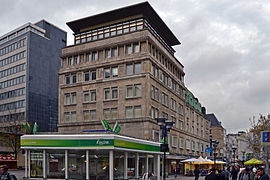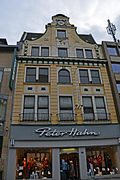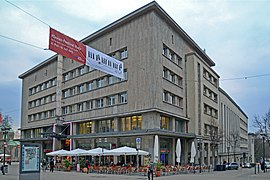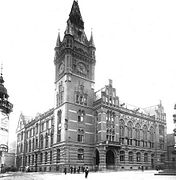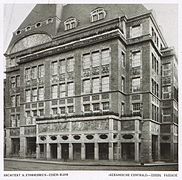Kettwiger Strasse
| Kettwiger Strasse | |
|---|---|
| Street in Essen | |
| Kettwiger Strasse, view from Willy-Brandt-Platz in north direction, on the right the house at Kettwiger Tor | |
| Basic data | |
| place | eat |
| District | City center |
| Hist. Names | platea Kettwich, Kettwiger Strate, In der Burg, Burgstrasse, Adolf-Hitler-Strasse |
| Cross streets | Lindenallee, Kapuzinergasse, II. Dellbrügge, Am Glockenspiel, I. Dellbrügge, Zwölfling, An St. Quentin, Porscheplatz |
| Buildings | Hotel Handelshof , Eickhaus , cathedral , St. Johann Baptist , Burgplatz , Baedekerhaus , Lichtburg , market church |
| use | |
| User groups | Foot traffic |
| Road design | Pedestrian zone |
| Technical specifications | |
| Street length | 0.4 km |
The Kettwiger road is a central shopping street in Essen city center . It was converted into a pedestrian zone in the late 1950s .
Location and traffic
The Kettwiger Straße begins in a south-north direction at Willy-Brandt-Platz, named after the German politician Willy Brandt , and leads over 400 meters almost in a straight line to the flax market.
Until it was converted into a pedestrian zone in the late 1950s, it had been used by trams and cars.
History and street names
The entire 900-meter-long north-south street from the former Viehofer to Kettwiger Tor is part of the Strata Coloniensis , one of the five old streets from the early Middle Ages that connected Cologne with the surrounding area. This street then crossed Hellweg , which ran in an east-west direction and which is now called Limbecker Straße in one section in the Essen city center . Around 850, near the intersection of these two important trade routes, Altfrid founded the Essen Abbey , the beginning of today's city of Essen.
According to old city plans, the street section between Kettwiger Tor and Street I. Dellbrügge was already called Kettwiger Strasse when the city wall existed ; first mentioned by name in written sources in 1330 as platea Kettwich , later Kettwiger Strate . It is named after the old farmers of Kettwig south of the city wall (has nothing to do with today's Kettwig district ). The further course from the I. Dellbrügge to the Marktkirche is known as In der Burg before 1826 and as Burgstrasse from around 1860 . The rest of the northern section was Viehofer Straße . The avenue to the southwest beyond the former Kettwiger Tor was called Kettwiger Chaussee in the 19th century and was named Huyssenallee in 1906 and then Rüttenscheider Straße . At the Kettwiger Tor, the Bochum – Duisburg railway crossed Kettwiger Strasse with a barred level crossing from 1862 . On June 15, 1899, the raised, level-free track superstructure was put into operation, and Kettwiger Strasse was thus passed underneath it without crossing.
After the seizure of power , the entire street (Kettwiger Strasse, Burgstrasse and Viehofer Strasse) was renamed Adolf-Hitler-Strasse on April 20, 1933, on Hitler's birthday . After the approximately 90 percent destruction of downtown Essen in the Second World War , all of the adjacent historical buildings that still exist today were rebuilt or fundamentally repaired. On May 15, 1945, after the end of the Nazi era , the street in the southern course was given its name back to Kettwiger Straße, in the north the name Viehofer Straße. The middle area, which was previously Burgstrasse, has now also become Kettwiger Strasse.
When the large area between the main post office and the Hotel Handelshof was given its current name Willy-Brandt-Platz on May 18, 1994 , Kettwiger Strasse was shortened accordingly, so that it now bears this name between Willy-Brandt-Platz and Marktkirche.
Course from south to north
Today's Willy-Brandt-Platz
Opposite the north exit of Essen Central Station , Kettwiger Strasse began at the former southern city gate, the Kettwiger Tor. Together with today's Willy-Brandt-Platz, it forms the entrance to the city center, where it begins in the west with the main post office . Since 1933, the current corner building, a few meters back, has replaced the characteristic post office building with corner tower built in 1903.
To the north is the house of the Kaufhof , which has been located here since 1996 , formerly the Horten house with the ornamental aluminum tile facade designed by the architect Egon Eiermann . In the 19th century, the house of the Judicial Councilor Bohnstedt was still located on this property, at which the Bohnstedtgäßchen, later called Judengäßchen, branched off to the west. To the north of the alley was the front garden and exhibition room of the adjoining house of the art gardener Karl Böhnert, who had been designing today's city garden since around 1859 . Around 1910 the buildings gave way to the Grand Hôtel Royal , which was later called the Hotel Königshof . The Royal Cinema was located in the building between 1910 and 1913. This gave way to the German family department store ( DeFaKa ) built in 1930 at Kettwiger Straße 1a, which was rebuilt after the war and demolished in 1977 in favor of the Horten department store.
On the eastern side of Kettwiger Strasse, at today's Willy-Brandt-Platz, today's Hotel Handelshof has followed the station forecourt since 1912 , built according to a design by the Cologne architect Carl Moritz . Completely burned out during the war, it was rebuilt between 1952 and 1956 and has been a listed building since 1985. The building has a row of shops on Kettwiger Strasse. Previously, the much smaller hotel-restaurant Zum Adler with the Adlerkeller was located on this property . It was roughly the site of the former Kettwig Gate.
- At today's Willy-Brandt-Platz
2005; Kaufhof on the left, Eickhaus center , Hotel Handelshof on the right
1961 during the Lichtwochen : DeFaKa on the left, Eickhaus in the middle, Hotel Handelshof on the right
Old Kettwiger Strasse
Today Kettwiger Straße begins north of Willy-Brandt-Platz, where the Lindenallee branches off to the west. The Eickhaus of the former furniture company A. Eick Söhne from 1915 is here. The house, built according to plans by Georg Metzendorf , was repaired after the war and has been a listed building since 2000. The fashion chain Anson's Herrenhaus now takes up the largest area of the house. Before that, there was Johann Schulte's inn, which in 1894 had to give way to a characteristic, three-story building with an upscale beer bar, which was demolished again in 1910. North of the Eickhaus, along Kettwiger Strasse, was the Derendorf House, which was completely destroyed in the war. The successor building was adapted to the Eickhaus.
The house at Kettwiger Tor has stood on the eastern side of Kettwiger Strasse since 1954. It got its name because of its proximity to the former city gate and was designed by Wilhelm Eggeling . The six-storey, curved office wing with a two-storey front building with shops should architecturally suggest a person with open arms who receives city visitors from the train station at Kettwiger Tor. In 2013/2014, the building complex was gutted and completely renovated. The former shopping arcade on Akazienallee fell away. Before the war, this was the location of the Hotel Stemme with the adjoining, first vending machine restaurant, as well as a slate-clad farm house , in which the Schulte paper shop and the milliner Derendorf were located around the turn of the century.
Further north on the western side of the street, at the corner of Kapuzinergasse, is the Stein commercial building, built from sandstone blocks, at Kettwiger Straße 5, which extends to Rathenaustraße, which runs parallel and is named after the architect Anton Stein . It was built in 1925 and listed as a historical monument in 1991. On the next western side street to the north, the street Am Glockenspiel , there is a corner house that the architect Wilhelm Koep designed especially for the Café Overbeck , which was located there between 1956 and December 2014 . It was built in 1955 and 1956 and is considered a model architecture of the 1950s, so it was listed as a historical monument in April 2015.
Directly opposite the street Am Glockenspiel, on the eastern side of the Kettwig street, you will find the Deiter Glockenspiel . Erected in 1928 on Limbecker Straße , it was hidden during the war and reinstalled in 1948 on the house at Kettwiger Straße 22 with the miners' figures acquired in 1938. At the turn of the century 1900 there was an old row of houses, which from south to north housed Franz Real's arms and hardware store , the general cinematograph theater , the Schneider photographer's studio , the Samson shoe store and Eugen Stemmerich's hotel with its own distillery. Around 1912 new houses were built here with an alignment that was offset to the rear, including one with the Union Theater and one with the Atrium cinema . At Kettwiger Strasse 24, where Kepa , later Karstadt Hören undlesen (Höle) and the fashion chain New Yorker were between the 1950s and 1970s , and from 2018 Woolworth will be, the cabaret Arkadia , later Regina Bar , was located before the war Areg vending machine restaurant and the Eden dance restaurant . Only an old facade, here with the inscription AD 1912 , has been preserved from the pre-war row of houses. Otherwise she would completely fall victim to the bombing war. Today's post-war buildings with their numerous retail stores have been rebuilt on this last line of flight.
Directly on the opposite side of the street, at Kettwiger Straße 19, the old facade of the former Gasthof zur Post by Theodor Volmer has been preserved. The house was built according to plans by the Essen architect Ernst Knoblauch and rebuilt around 1906. The mail coaches of the postman Joseph van Eupen stood in the backyard of what would later become the inn much earlier, because the postman and post office was on duty between 1826 and 1848 on Alte Poststrasse, today's Theaterplatz at the Grillo Theater . In 1930 the Gasthof Zur Post became the Gasthaus Zum Ritter . The limestone facade has been restored after war damage. It has been a listed building since 2006. To the north of it, at the corner of Alte Poststrasse and Kettwiger Strasse, there was the first Prussian post office in Essen around 1800 . Towards the end of the 19th century, the Überfeldt toy doll shop was located in the corner house . Opposite Poststrasse, partly on today's wide passage to the Grillo Theater, stood the four-story brick building of the Royal Railway Operations Office .
At the corner of I. Dellbrügge / Kettwiger Straße, where the men's outfitter Pohland has been based since 1963 and closed at the end of 2016 due to bankruptcy, the Hotel Höltgen was once located . The stock exchange was held there around 1880. In 1925, the Essen stock exchange was moved into what is now the Haus der Technik . The Hotel Höltgen was later called Hotel Bessenbach . The building no longer exists, as does the house adjoining it to the south, which housed the Tewes bakery and restaurant around 1880, which later bore the name Zum Kanonier .
- Upper Kettwiger Strasse
Burgstrasse, today Kettwiger Strasse
The former Burgstrasse, which was annexed by name to Kettwiger Strasse after the war, begins at I. Dellbrügge and the opposite Theaterplatz with the Grillo-Theater, previously Alte Poststrasse.
On the east side of today's corner building is the Lichtburg , a cinema opened in 1928, which today has the largest cinema in Germany with 1250 seats. Except for the facade, it was destroyed in the war and was later rebuilt. In 1998 the Lichtburg was placed under monument protection. A monastery building in the classicism style , which also bore the names Der Rittberger Hof and Das Löwenhaus , previously stood on the property . From 1821 to 1862 it was the location of the Royal Mining Authority , with its director, Oberbergrat Heintzmann, living on the first floor. Then the main post office in Essen and the telegraph office moved here. In 1903, the post office moved into the new building on Märkische Strasse at the main train station, today Hachestrasse. After the renovation in 1904, the municipal museum was finally located on the first floor of the former monastery building.
To the north, between Lichtburg and Burgplatz, stands the Kaiser Wilhelm monument designed by Hermann Volz in 1898, directly on Kettwiger Strasse. The equestrian statue, initially erected in the middle of Burgplatz, was moved to this location in 1928 and listed as a historical monument in 1994.
- Obere Burgstrasse, today Kettwiger Strasse
St. Johann Baptist on Kettwiger Strasse
2009: left Baedekerhaus , right St. Johann Baptist
today's Lichtburg
1895: St. Johann Baptist on the right, the Grillo House on the left, behind the tower of the town hall
The nucleus of the city of Essen
In the area of the Burgplatz, the Astnithi court of the founder of the Abbey, Altfrid, is assumed, from which the Essen Abbey and the city derive their name. The Burgplatz, which is connected to Kettwiger Straße by a wide staircase, is therefore considered to be the nucleus of the city of Essen. To the northwest of Burgplatz, Kettwiger Strasse runs past the St. Johann Baptist Church , which belonged to Essen Abbey. It borders the Essen Cathedral to the east , the church of the Essener Damenstift founded around 845, around which the city of Essen developed. Since 1958 the cathedral has been the bishopric of the Ruhr diocese .
Northern course
Opposite the castle square is the publisher after Gottschalk Diedrich Baedeker named Baedekerhaus , between 2008 and 2012. by the bookstore chain Thalia and since January 2018 Mayersche bookstore used. Instead of today's Baedekerhaus, there was a residence of the canons of Essen, the so-called Von Harrach'sche Kuria . The house had been acquired by Gottschalk Diedrich Baedeker in 1817 in order to run his printing and bookshop there. The house of the middle-class Huyssen family used to stand north of it . The current Baedeker building was built in 1927 and 1928 and served as the office of GD Baedeker Verlag . Its shell limestone facade bears sculptures by Joseph Enseling . In 1987 the building was listed as a historical monument, as was the textile department store adjacent to the north, owned by the Jewish merchant Gustav Blum (1879–1935) from 1928 with around 600 employees at the time. In 1938 his sons were forced by the National Socialists to sell the business below value in the course of the Aryanization . The Loosen department store then moved there. Since the gutting of the building in 1989, Peek has been located. & Cloppenburg in it. It has its longest side on Kardinal-Hengsbach-Platz and its east side touches Kettwiger Straße. In place of the house of Peek & Cloppenburg, there was previously the Lichtenstein Curia , a residence of the canons of Essen. The entrepreneur Friedrich Grillo had it converted into his home. The city gallery was later housed in the house , after which the city councilor and founder Heinrich Carl Sölling lived there . To the north of the house, Surmanngasse used to branch off to the west where Kurienplatz was laid out in 1925. Named after the curia, i.e. a residence of the canons , it was named Kardinal- Hengsbach- Platz in 1994.
The department store of the Primark chain has been located north of Kardinal-Hengsbach-Platz since 2011 ; it was built in 1980 for C&A , but C&A moved out in 2009. In 1934, a commercial building for C&A was built here by the architect Sepp Kaiser . Opposite, on the eastern side of the Kettwig street, there has been a new building for the Essen shoe company Deichmann since 2012 . Schuh Voswinkel was based in the previous building until around 2009 . Around 1900 , the hotel-restaurant Monopol stood on this and the property of the neighboring house to the north, which is now a perfumery and previously Woolworth's was there . Then the street Zwölfling, once a mountain street, branches off to the east. At the corner of Kettwiger Strasse 44 is the listed department store, in which AppelrathCüpper has been based since 1994 . It was completed in 1914 as the Schürmann furniture store based on plans by the architect Oskar Schwer . The Hettlage department store was there between 1934 and 1994 . The Voss Hotel was located in the previous building around 1900 .
On the opposite corner plot of Kettwiger Strasse / Flachsmarkt there were several former town halls of the city of Essen. Between the 13th and the middle of the 20th century, this location was the political center of the city. The old town hall was demolished after the property was sold in 1964/1965. Then came the Wertheim department store , which in 1986 gave way to today's office building by architects Genheimer & Partner from Essen.
The Kettwiger Straße ends in the north at Flachsmarkt, north of the market church, which was rebuilt after the war and originated in the 11th century. It was the focus of the medieval market. In the 16th century it became the first church in Essen to become Protestant due to an occupation by the bourgeoisie and conflicts with the Catholic women's monastery . In 1985 it was placed under monument protection. The sloping piece between the market and the flax market was called Marktberg and was very narrow before the Second World War. The tram has been going through here since 1893. Destruction of the war resulted in today's wide passage, which now forms the continuation of the Kettwiger to Viehofer Straße. The last house is at number 64. It is the former Ceramic Central , a building that had a facade decoration made of ceramic reliefs. After the ceramics were removed by the National Socialists and the damage was destroyed in the war, the house underwent several renovations after reconstruction, whereby in 1994 relief remains were discovered under the plaster, which were placed under monument protection.
- Untere Burgstrasse, today Kettwiger Strasse
Blum House , today Peek & Cloppenburg on Kardinal-Hengsbach-Platz
1908: View from the Marktkirche to the south, on the right the old town hall, in front of it the Alfred Krupp monument , in the back the church of St. Johann Baptist
Ceramic house around 1912
See also
Web links
Individual evidence
- ↑ Monika Fehse: Food. History of a city . Ed .: Ulrich Borsdorf. Peter Pomp Verlag, Bottrop, Essen 2002, ISBN 3-89355-236-7 , p. 179, 180 .
- ↑ Tony Kellen: The industrial city of Essen in words and pictures. History and description of the city of Essen. At the same time a guide through food and the surrounding area. Fredebeul & Koenen, Essen 1902, p. 61 .
- ↑ Erwin Dickhoff: Essener streets - city history in the mirror of street names . 2nd Edition. Richard Bacht-Verlag, Essen 1986, ISBN 978-3-87034-030-8 .
- ↑ a b c d e Hugo Rieth: Essen in old views, Volume 1 . 3. Edition. Zaltbommel, Netherlands 1978.
- ^ Hotel Handelshof in the list of monuments ; Retrieved January 5, 2017
- ↑ Eickhaus in the list of monuments ; Retrieved January 5, 2017
- ↑ a b c d e Hugo Rieth: Essen in old views, Volume 2 . 7th edition. Zaltbommel, Netherlands 1991, ISBN 978-90-288-3097-4 .
- ^ Stone house in the list of monuments ; Retrieved January 5, 2017
- ↑ Café Overbeck office building in the list of monuments ; Retrieved January 5, 2017
- ↑ Retail demands impulses for the city of Essen ; In: Westdeutsche Allgemeine Zeitung from January 4, 2018
- ↑ Hotel zur Post in the list of monuments ; Retrieved January 5, 2017
- ↑ DerWesten.de of September 16, 2016: After 53 years: Pohland closes on Kettwiger Straße
- ↑ Lichtburg in the list of monuments ; Retrieved January 5, 2017
- ↑ Holger Krüssmann: Architecture in Essen 1900–1960 . Ed .: Berger Bergmann and Peter Brdenk. Klartext, Essen 2012, ISBN 978-3-8375-0246-6 .
- ↑ Equestrian statue in the list of monuments ; Retrieved January 5, 2017
- ↑ Baedekerhaus in the list of monuments ; Retrieved January 5, 2017
- ^ Department store Blum in the list of monuments ; Retrieved January 5, 2017
- ↑ Marktkirche in the list of monuments ; Retrieved January 5, 2017
- ↑ Excerpt from the list of monuments of the city of Essen ; Retrieved January 5, 2017






